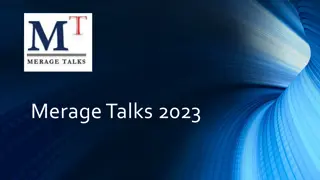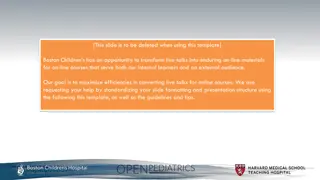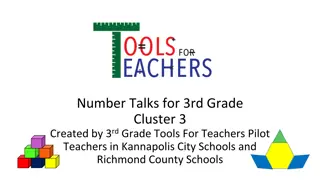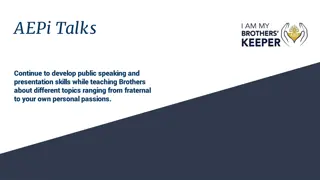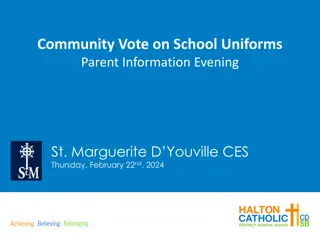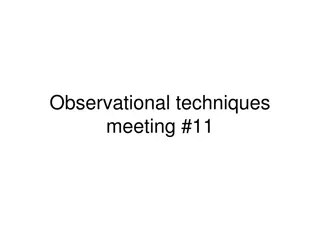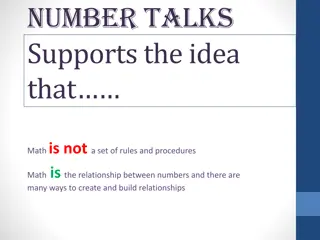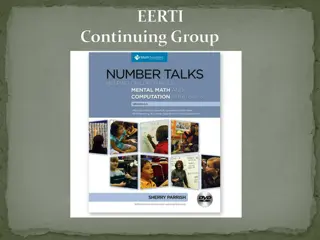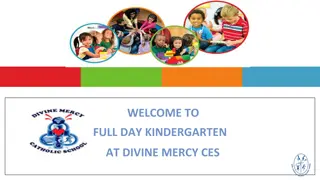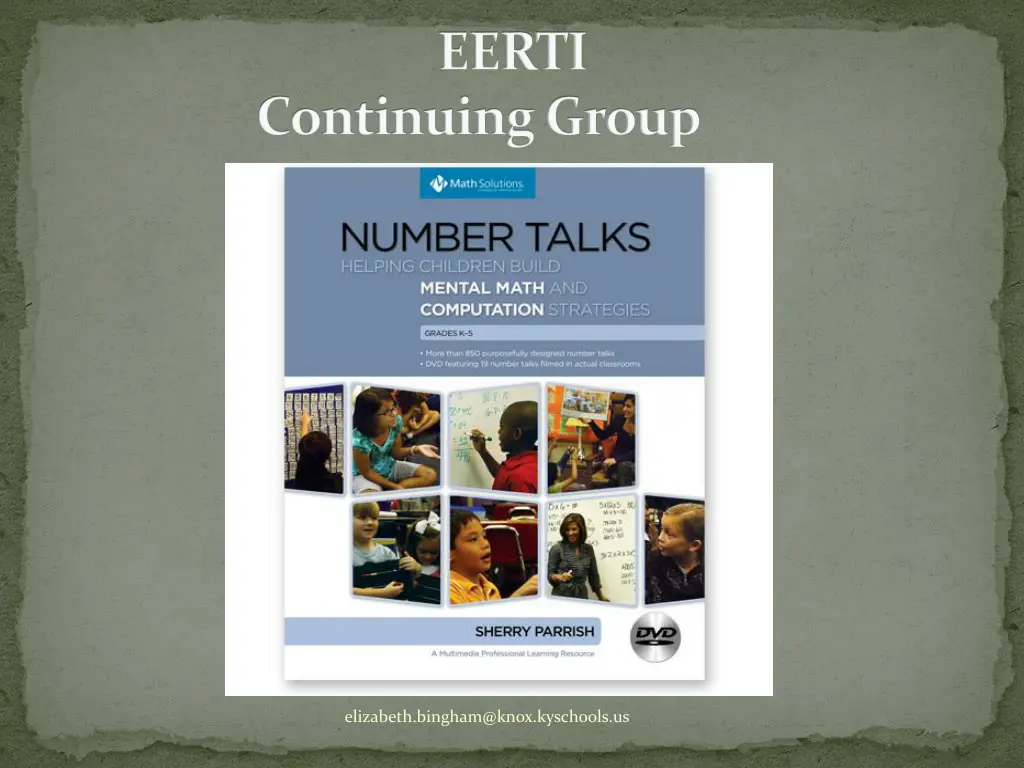
Benefits of Number Talks for Math Learning
Explore the benefits and key components of Number Talks in math education. Discover how students clarify their thinking, test strategies, and build efficient problem-solving skills. Understand the teacher's role as a facilitator in fostering classroom conversations and modeling recording strategies to enhance mathematical understanding.
Download Presentation

Please find below an Image/Link to download the presentation.
The content on the website is provided AS IS for your information and personal use only. It may not be sold, licensed, or shared on other websites without obtaining consent from the author. If you encounter any issues during the download, it is possible that the publisher has removed the file from their server.
You are allowed to download the files provided on this website for personal or commercial use, subject to the condition that they are used lawfully. All files are the property of their respective owners.
The content on the website is provided AS IS for your information and personal use only. It may not be sold, licensed, or shared on other websites without obtaining consent from the author.
E N D
Presentation Transcript
EERTI Continuing Group elizabeth.bingham@knox.kyschools.us
Elizabeth Jean Bingham Central Elementary Elizabeth.bingham@knox.kyschools.us elizabeth.bingham@knox.kyschools.us
Key Components of Number Talks 1. Classroom environment is the key!! build a cohesive math community a risk-free environment designate a place the students sit altogether on the floor a place to write . in Number Talks the teacher does the recording elizabeth.bingham@knox.kyschools.us
T.3 CLIP 3RD GRADE TEACHER elizabeth.bingham@knox.kyschools.us
2. Classroom Discussion computation is done mentally provide plenty of time use a signal such as thumbs on their chest to show they have the answer students share their strategies and justifications with their peers elizabeth.bingham@knox.kyschools.us
The benefits of Number Talks are: students clarify their own thinking test other strategies to see if they are logical apply number relationships build a repertoire of efficient strategies learn how to talk about math elizabeth.bingham@knox.kyschools.us
3. The Teacher's Role The heart of Number Talks is classroom conversations. teacher becomes the facilitator teacher writes down all the students' answers students "justify" their answers by sharing their strategies While the student is explaining a strategy the teacher is recording the strategy on the board. It is a great way to model recording strategies! elizabeth.bingham@knox.kyschools.us
Teacher poses questions students lead the conversation By changing the question from "What answer did you get?" to "How did you solve this problem?" the teacher is able to understand how the students are making sense of mathematics. Don't be afraid to share incorrect solutions. Wrong answers can lead to great classroom discussion and point out misconceptions a student may have. elizabeth.bingham@knox.kyschools.us
4. The Role of Mental Math help the students focus on number relationships help them use these relationships to solve problems When students approach problems without paper and pencil, they are encouraged to rely on what they know 1. what they understand about the numbers 2. how they are interrelated. 3. elizabeth.bingham@knox.kyschools.us
CLASSROOM CLIP 5.3 16 x 35 5TH Grade elizabeth.bingham@knox.kyschools.us
5. Purposeful Computation Problems Careful planning before a number talk design the problem that is "just right" The learning target should determine the numbers and operations that are chosen. elizabeth.bingham@knox.kyschools.us
HOW DOES NUMBER TALKS RELATE TO MATH elizabeth.bingham@knox.kyschools.us
MATHEMATICAL PRACTICES 1 - 4 elizabeth.bingham@knox.kyschools.us
MATHEMATICAL PRACTICES 5 - 8 elizabeth.bingham@knox.kyschools.us
Number Talk Ideas: Try to do every day for a small amount of time (10-15 minutes) a few minutes often is much better than a lot of minutes every once in awhile. NO MORE THAN 15 MINUTES Establish a routine thumbs up when you are ready and have an answer another finger up if you have another way to solve this problem. elizabeth.bingham@knox.kyschools.us
Ask questions and let the kids do the talking! What did you see? How did you see it? Did anyone see it a different way? How did you think about that? How did you figure it out? What did you do next? Why did you do that? Did someone solve the problem a different way? What strategies do you see being used? elizabeth.bingham@knox.kyschools.us
Use different mediums Whiteboard chart paper smartboard elizabeth.bingham@knox.kyschools.us
Name/label the strategies that your students talk about using doubles counting on doubles+1 constant difference decompose make a ten counting on ETC friendly number doubling and halving partial product elizabeth.bingham@knox.kyschools.us
TO HELP STUDENTS GET STARTED sentence starters "My strategy was..." "I agree/disagree with you because..." "I know a different way..." "I hear you say that..." "What would happen if..." elizabeth.bingham@knox.kyschools.us
*Create a safe environment during the number talks elizabeth.bingham@knox.kyschools.us
KINDERGARTEN CLASSROOM K.1 CLIP KINDERGARTEN CLASSROOM elizabeth.bingham@knox.kyschools.us
Questioning For the teacher, you should see questions that are generally open and probing for meaning. For the students, you should see encouragement student-to-student talk in small groups by helping each other clarify where they are having difficulty and focusing on making sense of the problem, not just put numbers into a formula elizabeth.bingham@knox.kyschools.us
Explaining Mathematical Thinking For the teacher, you should see a teacher asking for more than one way to solve the problem. For the student, you should see students sharing their thinking with each other and whole class without prompting or little probing from teacher. elizabeth.bingham@knox.kyschools.us
Source of Mathematical Ideas For the teacher, you should see teachers working with student errors or letting the student s ideas guide the direction of lesson. For the students, you should see students relying on their own ideas or thinking. Their ideas are valued and worthwhile. elizabeth.bingham@knox.kyschools.us
Responsibility for Learning For the teacher, you should see teachers supporting students as they evaluate each other s work or thinking. For the students, you should see students agreeing or disagreeing with each other in order to understand elizabeth.bingham@knox.kyschools.us
Is MATH TALK a waste of my time? elizabeth.bingham@knox.kyschools.us
PROFESSIONAL GROWTH AND EFFECTIVENESS SYSTEM FRAMEWORK FOR TEACHING PROFICIENCY SYSTEM Comp. 2A: Creating an Environment of Respect and Rapport Comp. 2B: Establishing a Culture for Learning Comp. 2C: Managing Classroom Procedures Comp. 2D: Managing Student Behavior Comp. 3A: Communicating with Students Comp. 3B: Using Questioning/Prompts and Discussion Techniques Comp. 3C: Engaging Students in Learning Comp. 3D: Using Assessment in Instruction elizabeth.bingham@knox.kyschools.us
Five Talk Moves 1. Revoicing. ( So you re saying that it s an odd number? ) : When students talk about mathematics, it s often very difficult to understand what they say. 2. Repeating: Asking Students to Restate Someone Else s Reasoning. ( Can you repeat what he just said in your own words? ) 3. Reasoning: Asking students to Apply Their Own Reasoning to Someone Else s Reasoning. ( Do you agree or disagree and why? ) elizabeth.bingham@knox.kyschools.us
4. Adding on: Prompting Students for Further Participation. ( Would someone like to add something more to this? ) 5. Waiting: Using Wait Time. ( Take your time..we llwait ) elizabeth.bingham@knox.kyschools.us
NUMBER TALKS ARE Students TALKING about their mathematical reasoning Students using mathematical lingo Students proposing multiple solutions or ways of solving a problem Students analyzing and critique the solutions and shared thought processes of their peers elizabeth.bingham@knox.kyschools.us
MORE QUESTIONING Help us understand your thinking? Did anyone else think of this differently? Does everyone have the same idea? What questions do you have? What is confusing? What was the big idea that helped you make sense of this? What are people still wondering? elizabeth.bingham@knox.kyschools.us
NUMBER TALKS ARE SHORT MATH TALKS STUDENTS TALKING STUDENTS THINKING STUDENTS EXPLAINING /JUSTIFYING TEACHER WRITING EYE OPENING A SAFE ENVIRONMENT elizabeth.bingham@knox.kyschools.us
Third Grade Classroom 3.7 Multiplication String 7 X 7 elizabeth.bingham@knox.kyschools.us
MAKE AND TAKE elizabeth.bingham@knox.kyschools.us

![❤[PDF]⚡ Civil War Talks: Further Reminiscences of George S. Bernard and His Fel](/thumb/20551/pdf-civil-war-talks-further-reminiscences-of-george-s-bernard-and-his-fel.jpg)

